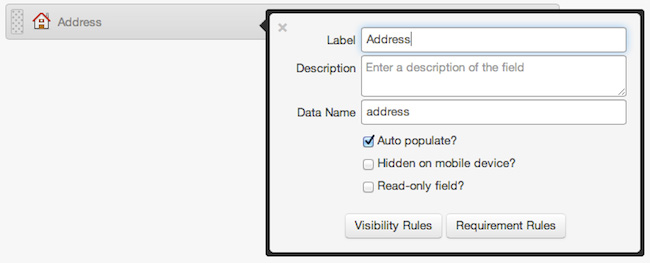Auto-populate your address fields
As you may or may not know, one of the best features of Fulcrum is the drag and drop form builder. Recently, we added support for a new type of field that many users have asked for: address fields with reverse geocoding.

Like most field types, you can set a label, description, and required status for address fields. Additionally, you can control their visibility. Address fields uniquely offer the “Auto Populate” option. This option signals the mobile client to conduct “reverse geocoding” on the linked location.
Reverse geocoding transforms latitude and longitude into physical addresses. Services from Google or Apple enable the mobile client to autofill details like street name, city, state, and postal code. However, these services might not identify every part, such as the street number, leaving some fields empty. Nevertheless, you have the option to manually edit each address component.
Moreover, when you export your collected data, the system separates address fields into various columns for each address part. The names of the columns follow the specification written by the OASIS Customer Information Quality Committee (CIQ) and are listed below with their respective U.S. address equivalents.
- sub_thoroughfare: Street Number
- thoroughfare: Street Name
- suite: Apt / Suite / Unit
- locality: City
- sub_admin_area: County
- admin_area: State / Province
- postal_code: Postal / Zip Code
- country: Country Name
We hope you will find the new auto-populating address field to be extremely useful and time saving in your data collection efforts. As always, we welcome feedback and suggestions on new and existing features, so please contact us and let us know!
Benefits of auto-population
And, just in case you’re wondering why auto-populating address fields is such a big deal:
Auto-populating address fields in field inspections saves time and reduces errors. It also improves accuracy and efficiency. Inspectors typically collect a lot of data, including the inspection location’s address. Manual entry of this information is slow and error-prone, especially for complex addresses.
Auto-population technology automatically fills address fields using GPS coordinates or database searches. This eliminates the need for manual entry, saving time and effort. Moreover, it reduces errors and ensures accurate and complete information collection. For example, in areas with similar addresses, manual entry might result in incorrect data. Auto-population ensures the correct address is filled based on GPS, reducing error risks.
Overall, auto-populating address fields streamlines data collection, enhances accuracy, and lowers error chances. This leads to more efficient inspections, better data quality, and improved outcomes for inspectors and their organizations.




